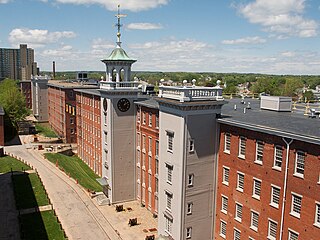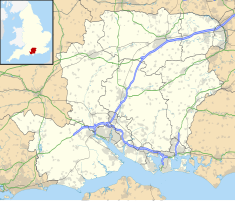
Lowell National Historical Park is a National Historical Park of the United States located in Lowell, Massachusetts. Established in 1978 a few years after Lowell Heritage State Park, it is operated by the National Park Service and comprises a group of different sites in and around the city of Lowell related to the era of textile manufacturing in the city during the Industrial Revolution. In 2019, the park was included as Massachusetts' representative in the America the Beautiful Quarters series.

Quarry Bank Mill in Styal, Cheshire, England, is one of the best preserved textile factories of the Industrial Revolution. Built in 1784, the cotton mill is recorded in the National Heritage List for England as a designated Grade II* listed building. Quarry Bank Mill was established by Samuel Greg, and was notable for innovations both in machinery and also in its approach to labour relations, the latter largely as a result of the work of Greg's wife, Hannah Lightbody. The family took a somewhat paternalistic attitude toward the workers, providing medical care for all and limited education to the children, but all laboured roughly 72 hours per week until 1847 when a new law shortened the hours.

The River Blackwater is a tributary of the Loddon in England and sub-tributary of the Thames. It rises at two springs in Rowhill Nature Reserve between Aldershot, Hampshire and Farnham, Surrey. It curves a course north then west to join the Loddon in Swallowfield civil parish, central Berkshire. Part of the river splits Hampshire from Surrey; a smaller part does so as to Hampshire and Berkshire.

The Society for the Protection of Ancient Buildings (SPAB) is an amenity society founded by William Morris, Philip Webb, and others in 1877 to oppose the destructive 'restoration' of ancient buildings occurring in Victorian England. "Ancient" is used here in the wider sense rather than the more usual modern sense of "pre-medieval."
The Landmark Trust is a British building conservation charity, founded in 1965 by Sir John and Lady Smith, that rescues buildings of historic interest or architectural merit and then makes them available for holiday rental. The Trust's headquarters is at Shottesbrooke in Berkshire.

Whitchurch is a town in the borough of Basingstoke and Deane in Hampshire, England. It is on the River Test, 13 miles (21 km) south of Newbury, Berkshire, 12 miles (19 km) north of Winchester, 8 miles (13 km) east of Andover and 12 miles (19 km) west of Basingstoke. Much of the town is a Conservation Area. Because of the amount of wildlife in and near the River Test, its course and banks are designated as Site of Special Scientific Interest. Whitchurch is the Gateway to the North Wessex Downs National Landscape; the third largest of Britain's National Landscapes.

Stotfold is a town and civil parish in the Central Bedfordshire district of Bedfordshire, England. The town covers 2,207 acres (8.93 km2) and the River Ivel passes through the town. The population of the parish at the 2021 census was 9,014. The wider built-up area, which the Office for National Statistics defines to additionally include the adjoining Fairfield Park development, had a population of 12,310 at the 2021 census. For the purposes of postal addresses, Stotfold comes under the post town of Hitchin; it was therefore in the postal county of Hertfordshire despite actually being in Bedfordshire.

The Weald and Downland Living Museum is an open-air museum in Singleton, West Sussex. The museum is a registered charity.

Woodbridge Tide Mill in Woodbridge, Suffolk, England is a rare example of a tide mill whose water wheel still turns and is capable of grinding a wholemeal flour.

Bursledon Windmill is a Grade II* listed windmill in Bursledon, Hampshire, England which has been restored to working order.

Stembridge Tower Mill in High Ham, Somerset, England, is the last remaining thatched windmill in England. The mill is a grade II* listed building.

The River Whitewater rises at springs near Bidden Grange Farm between Upton Grey and Greywell in Hampshire, England. It flows northeast and is a tributary of the River Blackwater near Swallowfield. Its headwaters flow over chalk and there is little pollution making the River Whitewater rich in wildlife. It was noted on Jansson's map of Hampshire of 1646.

The Mills Archive was established in 2002 to preserve and protect records of milling heritage and to make them freely available to the public. It is governed by the Mills Archive Trust, which is a charity that is based at Watlington House, Reading, Berkshire, England.

Thwaite Mills or Thwaite Watermill is an industrial heritage site in Leeds, West Yorkshire, England, on the River Aire and the Aire and Calder Navigation. It is a fully restored working water-powered mill built in 1823-25, harnessing the power of the river, and has been called "one of the best last remaining examples of a water-powered mill in Britain". The mill, the manager's house and three associated buildings are all grade II listed buildings. The site was open to the public as a museum operated by Leeds City Council until 1 April 2024.

Bunbury Mill is a watermill located to the east of the village of Bunbury, Cheshire, England. After being at risk of demolition, it has been restored as a working museum. The structure is designated by Historic England as a Grade II listed building.

The Weavers' Triangle is an area of Burnley in Lancashire, England consisting mostly of 19th-century industrial buildings at the western side of town centre clustered around the Leeds and Liverpool Canal. The area has significant historic interest as the cotton mills and associated buildings encapsulate the social and economic development of the town and its weaving industry. From the 1980s, the area has been the focus of major redevelopment efforts.

Queen Street Mill is a former weaving mill in Harle Syke, a suburb to the north-east of Burnley, Lancashire, that is a Grade I listed building. It now operates as a museum and cafe. Currently open for public tours between April and November. Over winter the café is opened on Wednesdays. It is also viewable with private bookings.

Congleton, Macclesfield, Bollington and Stockport, England, were traditionally silk-weaving towns. Silk was woven in Cheshire from the late 1600s. The handloom weavers worked in the attic workshops in their own homes. Macclesfield was famous for silk buttons manufacture. The supply of silk from Italy was precarious and some hand throwing was done, giving way after 1732 to water-driven mills, which were established in Stockport and Macclesfield.

The Knockando Woolmill is a historic woolmill in Moray, Scotland. Wool production has taken place at the site since at least the eighteenth century, and the surviving buildings house a number of pieces of historic machinery which are still in operation. It was designated a Category A listed building in 1995, still operates as a working mill, and is open to the public from April to September.

New Hall Mill is a watermill in Walmley, in Sutton Coldfield, West Midlands.





















